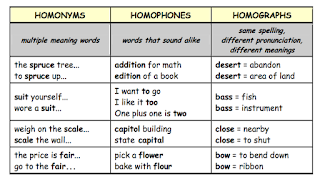HOMONYMS HOMOPHONES HOMOGRAPHS
Homonyms, or multiple meaning words, are words that share the same spelling and the same pronunciation but have different meanings. For example, bear.
A bear (the animal) can bear (tolerate) very cold temperatures.
The driver turned left (opposite of right) and left (departed from) the main road.
Homophones, also known as sound alike words, are words that are pronounced identically although they have different spellings and meanings.
These words are a very common source of confusion when writing.
Common examples of sets of homophones include: to, too, and two; they're and their; bee and be; sun and son; which and witch; and plain and plane.
Vocabulary Spelling City is a particularly useful tool for learning to correctly use and spell the sound alike words.
Homographs are words that are spelled the same, but have different meanings and different pronunciations.
Some examples of homographs are:
bass as in fish vs bass as in music,
bow as in arrow vs bow as in bending or taking a bow at the end of a performance,
close as in next to vs close as in shut the door,
desert as in dry climate vs desert as in leaving alone.
Currently, Vocabulary Spelling City cannot distinguish between homographs, as we are unable to have two pronunciations for the exact same word.
We are looking for possibilities in the future.
A HOMONYM IS ONE OF A GROUP OF WORDS THAT SHARE THE SAME SPELLING AND THE SAME PRONUNCIATION BUT HAVE DIFFERENT MEANINGS.
THIS USUALLY HAPPENS AS A RESULT OF THE TWO WORDS HAVING DIFFERENT ORIGINS.
THE STATE OF BEING A HOMONYM IS CALLED HOMONYMY.
A HOMOPHONE IS A WORD THAT IS PRONOUNCED THE SAME AS ANOTHER WORD BUT DIFFERS IN MEANING.
THE WORDS MAY BE SPELLED THE SAME, SUCH AS ROSE (FLOWER) AND ROSE (PAST TENSE OF "RISE"), OR DIFFERENTLY, SUCH AS CARAT, CARET, AND CARROT, OR TO, TWO AND TOO.
ALL HOMONYMS ARE HOMOPHONES BECAUSE THEY SOUND THE SAME. HOWEVER, NOT ALL HOMOPHONES ARE HOMONYMS.
HOMOPHONES WITH DIFFERENT SPELLINGS ARE NOT HOMONYMS.
* "ADVOCATE" CAN BE PRONOUNCED WITH A LONG "A" SOUND AND MEAN “TO SPEAK OR WRITE IN SUPPORT OF”
* "ADVOCATE" CAMN ALSO BE PRONOUNCED WITH A SHORT "A" SOUND AND REFER TO A PERSON WHO SUPPORTS OR PLEADS THE CAUSE OF ANOTHER.
HOMOGRAPH - “GRAPH” HAS TO DO WITH WRITING OR DRAWING.
WHEN YOU THINK ABOUT A GRAPH, YOU ENVISION A PICTURE.
IF YOU READ GRAPHIC NOVELS, YOU KNOW THEY HAVE PICTURES.
SOMEONE DREW THEM. SO “HOMOGRAPH” MEANS “SAME PICTURE” OR “SAME WRITING.”
HOMOGRAPHS ARE WRITTEN (SPELLED) THE SAME.
HOMOPHONE - “PHONE” HAS TO DO WITH SOUND. WHEN YOU TALK ON THE TELEPHONE, YOU HEAR THE OTHER PERSON’S VOICE.
WHEN PEOPLE IN THE 1800S USED A GRAMOPHONE, THEY WERE LISTENING TO MUSIC.
AND PHONOLOGY IS THE STUDY OF A LANGUAGE’S SOUNDS.
SO “HOMOPHONE” MEANS “SAME SOUND.”
HOMOPHONES ARE PRONOUNCED THE SAME.
HOMONYM - “NYM” MEANS “NAME.”
STEVIE NICKS AND STEVIE WONDER HAVE THE SAME FIRST NAME, BUT THEY CLEARLY ARE DIFFERENT PEOPLE.
IT’S THE SAME WITH HOMONYMS.
THEY’RE SPELLED THE SAME (HOMOGRAPHS) AND PRONOUNCED THE SAME (HOMOPHONES), BUT THEY HAVE DIFFERENT MEANINGS.
“BOW,” FOR EXAMPLE, MEANS BOTH “TO BEND AT THE WAIST” AND “THE FRONT OF A BOAT.”
Reference:
http://conceptsinsemantics.weebly.com/homograph-homonymy-homophones.html








0 komentar:
Posting Komentar